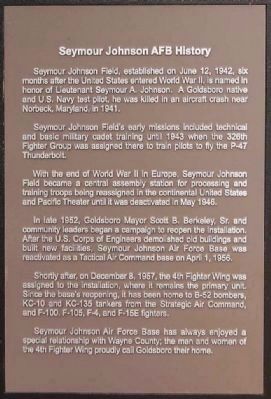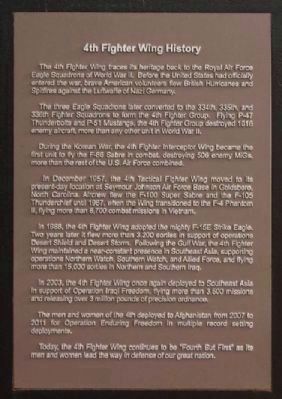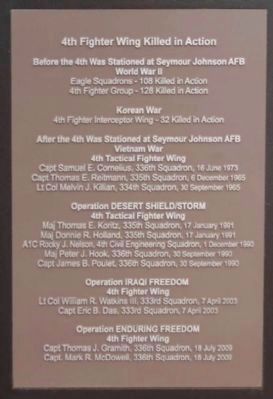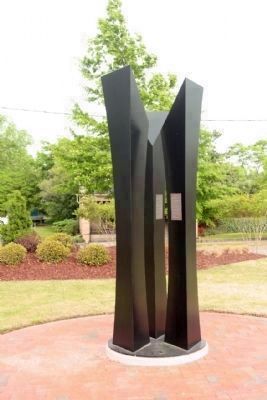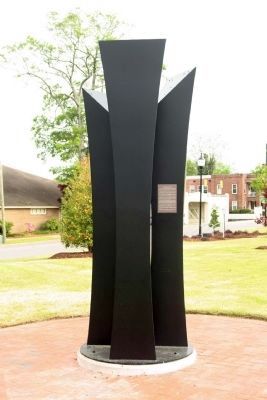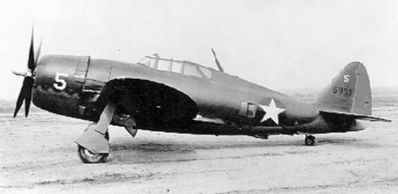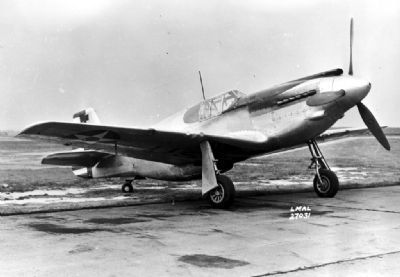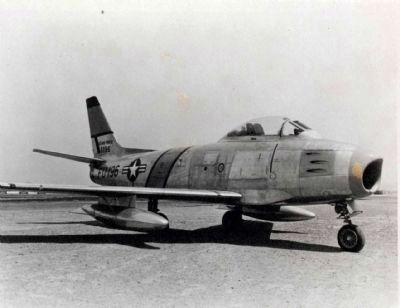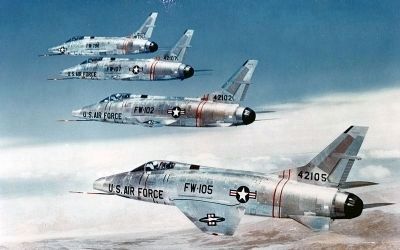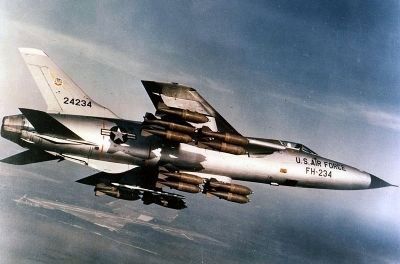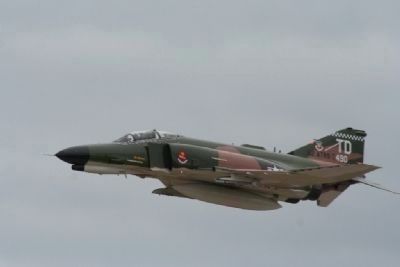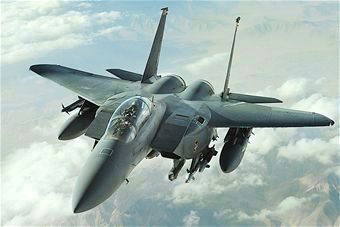Goldsboro in Wayne County, North Carolina — The American South (South Atlantic)
Seymour Johnson AFB History / 4th Fighter Wing History Memorial
Inscription.
Seymour Johnson Field, established on June 12, 1942, six months after the United States entered
World War II, is named in honor of Lieutenant Seymour A. Johnson. A Goldsboro native and U.S.Navy test
pilot, he was killed in an aircraft crash near Norbeck, Maryland, in 1941.
Seymour Johnson Field's early missions included technical and basic military cadet training until 1943 when the 326th Fighter Group was assigned there to train pilots to fly the P-47 Thunderbolts.
With the end of World War II in Europe, Seymour Johnson Field became a central assembly station for processing and training troops being reassigned in the continental United States and Pacific Theater until deactivated in May 1946.
In late 1952, Goldsboro Mayor Scott B. Berkeley, Sr. and community leaders began a campaign to reopen the installation. After the U.S. Corps of Engineers demolished old buildings and built new facilities, Seymour Johnson Air Force Base was reactivated as a Tactical Air Command base on April 1, 1956.
Shortly after, on December 8, 1957, the 4th Fighter Wing was assigned to the installation, where it remains the primary unit. Since the base's reopening, it has been home to B-52 bombers, KC-10 and KC -135 tankers from the Strategic Air Command, and F-100, F-105, F-4, and F-15E fighters.
Seymour Johnson Air Force Base has always enjoyed a special relationship with Wayne County; The men and women of the 4th Fighter Wing proudly call Goldsboro their home.
(Second plaque)
The 4th Fighter Wing traces its heritage back to the Royal Air Force Eagle Squadrons of World War II. Before the United States had officially entered the war, brave American volunteers flew British Hurricanes and Spitfires against the Luftwaffe of Nazi Germany.
The three Eagle Squadrons later converted to the 334th, 335th, and 336th Fighter Squadrons to form the 4th Fighter Group. Flying P-47 Thunderbolts and P-51 Mustangs, the 4th Fighter Group destroyed 1016 enemy aircraft, more than any other unit in World War II.
During the Korean War, the 4th Fighter Interceptor Wing became the first unit to fly the F-86 Sabre in combat, destroying 506 enemy MiGs,more than the rest of the U.S. Air Force combined.
In December 1957, the 4th Tactical Fighter Wing moved to its present-day location at Seymour Johnson Air Force Base in Goldsboro, North Carolina. Aircrew flew the F-100 Super Sabre and the F-105 Thunderchief until 1967, when the Wing transitioned to the F-4 Phantom II, flying more than 8,700 combat missions in Vietnam.
In 1988, the 4th Fighter Wing adopted the mighty F-15E Strike Eagle.
Two years later it flew more than
3,200 sorties in support of operations Desert Shield and Desert Storm. Following the Gulf War. the 4th
Fighter Wing maintained a near-constant presence in Southeast Asia, supporting operations Northern
Watch, Southern Watch, and Allied Force, and flying more than 15,000 sorties in Northern and Southern
Iraq.
In 2003, the 4th Fighter Wing once again deployed to Southeast Asia (?) in support of Operation Iraqi Freedom, flying more than 3,500 missions and releasing over 3 million pounds of precision ordnance.
The men and women of the 4th deployed to Afghanistan from 2007 to 2011 for Operation Enduring Freedom in multiple record setting deployments.
Today. the 4th Fighter Wing continues to be "Fourth But First" as its men and women lead the way in defense of our great nation.
(Third plaque)
Before the 4th was stationed at Seymour Johnson
World War II
Eagle Squadrons - 108 Killed in Action
4th Fighter Group - 128 Killed in Action
Korean War
4th Fighter Interceptor Wing - 32 Killed in Action
After the 4th Was Stationed at Seymour Johnson AFB
Vietnam War
4th Tactical Fighter Wing
Capt Samuel E. Cornelius, 336th Squadron, 16 June 1973
Capt Thomas E. Reitmann, 335th
Squadron, 30 September 1965
Lt Col Melvin J. Killian, 334th Squadron, 30 September 1965
4th Tactical Fighter Wing
Maj Thomas E. Koritz, 335th Squadron, 17 January 1991
Maj Donnie R. Holland, 335th Squadron,17 January 1991
A1C Rocky J. Nelson, 4th Civil Engineering Squadron, 1 December 1990
Maj Peter J. Hook, 336th Squadron, 30 September 1990
Capt James B. Poulet, 336th Squadron, 30 September 1990
4th Fighter Wing
Lt Col William R. Watkins III, 333rd Squadron, 7 April 2003
Capt Eric B. Das, 333rd Squadron, 7 April 2003
4th Fighter Wing
Capt Thomas J. Gramith, 336th Squadron, 18 July 2009
Erected by City of Goldsboro.
Topics. This historical marker and memorial is listed in these topic lists: War, 1st Iraq & Desert Storm • War, Korean • War, Vietnam • War, World II. A significant historical date for this entry is January 17, 1991.
Location. 35° 22.958′ N, 77° 59.621′ W. Marker is in Goldsboro, North Carolina, in Wayne County. Marker is on North William Street near East Walnut Street, on
the right when traveling south. Touch for map. Marker is in this post office area: Goldsboro NC 27530, United States of America. Touch for directions.
Other nearby markers. At least 8 other markers are within walking distance of this marker. Wayne County Veterans Memorial (a few steps from this marker); North Carolina Press Association (within shouting distance of this marker); John Lawson (within shouting distance of this marker); Company E, 119th Infantry, Goldsboro Rifles World War I Monument (within shouting distance of this marker); First Pentecostal Holiness Church Congregation (about 300 feet away, measured in a direct line); Goldsboro (about 400 feet away); Wm. T. Dortch (approx. 0.2 miles away); Charles B. Aycock (approx. 0.2 miles away). Touch for a list and map of all markers in Goldsboro.
Also see . . . Seymour Johnson Air Force Base. occupies over 3,300 acres (13 km²) in the southeast section of Goldsboro. Seymour Johnson Field was opened in April 1942 as Headquarters, Technical School, Army Air Forces Technical Training Command. In June 1943, a secondary mission was added which included preparation of officers and men for overseas duty. (Submitted on July 14, 2013, by Mike Stroud of Bluffton, South Carolina.)
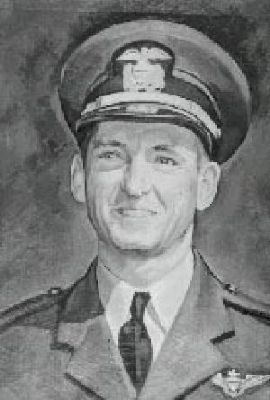
Photographed By Seymour Johnson Air Force Base
6. Navy Lt. Seymour A. Johnson
Air Force Base, N.C., was named in honor of Navy Lt. Seymour A. Johnson, a Goldsboro native who died in an airplane crash near Norbeck, Md., on March 5, 1941,
He was assigned to Anacostia Naval Air Station in Washington, D.C.
Credits. This page was last revised on March 20, 2021. It was originally submitted on July 13, 2013, by Mike Stroud of Bluffton, South Carolina. This page has been viewed 1,297 times since then and 49 times this year. Photos: 1, 2, 3, 4, 5, 6, 7, 8, 9, 10, 11, 12, 13. submitted on July 13, 2013, by Mike Stroud of Bluffton, South Carolina.
